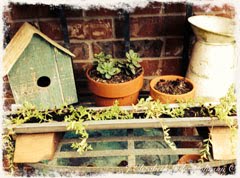
Today I'd like to talk about some projects you can do with children. I have some particular standards that I refuse to compromise on with kid's art.
1. I never do projects that look like they came out of a kid's crafts magazine. These projects are usually cheesy and require virtually no imagination.
2. I always do projects that allow and even require some imagination and creative choices by the child. If I take an example to class I tell the students that no one can make one just like mine. At the very least, change the colors.
3. I always try to use quality, although inexpensive, supplies. I think construction paper should be banned from the planet. It is awful to work with, it tears, it feels bad in your hands, and the color fades quickly. It doesn't cost that much to use a better quality paper.
4. Take the effort to do finishing touches, i.e. framing, matting, varnish, etc. You will be amazed at how much difference this will make. Take a child's piece of art, add a little varnish and suddenly it looks like folk art. Framing does the same thing and gives the piece significance in the child's (and your) eyes.
5. I only use non-toxic materials with children. No exceptions.
6. I only do the preparatory steps that are beyond the skill level of the child. Any other preparations or clean up, will be done by the kids. They need to learn the process and understand how to get "to" a project from the raw materials they have.
Project 1 Mosaic Flower Pot
I don't have a picture of this project. But its pretty simple and I'm sure you can imagine it. I came up with this idea when I wanted to do a mosaic piece with my students but couldn't find any instructions for a non-toxic adhesive.
supplies:
*1 clay pot (a younger child will want a smaller pot)
*white acrylic craft paint
*many colors of wrapping tissue paper - have it already cut into shapes about 1/2" - 3/4" in diameter. Its more interesting if they aren't all uniform shapes.
*varnish
*Modpodge, Royal Coat, or something equivalent
*sponge paint brush
1. Have the child paint the outside of the clay pot white. Let it dry. You can blow dry it if you are impatient like me. Then give it a second coat.
2. Show your little artist some pictures or real pieces of mosaic and encourage them to plan how they will create their design. They can work some of it out on the table. But kids don't usually have much patience for a whole lot of planning. They might want to make a recognizable image or they may want to just randomly place the colors on the pot. Let them choose. Don't push them to do what you want.
3. Show them how the mosaic examples have a space of grout in between the stones. Be careful not to call the example "real" verses their piece of "pretend". Just leave that part out.
4. Pour some of the Modpodge into a paper bowl and show the child how they can brush some lightly onto the pot. Then they take the tissue paper shapes and press them against the pot and dab the top with the sponge and a little Modpodge. Show them how leaving a space between their pieces of colored paper will help the white paint to look like the grout in their example.
5. When the pot is covered with papers and all the papers are covered with Modpodge, you will have to let this part air dry. No blow drying at this stage.
6. When totally dry, cover with at least one coat of varnish. The shine will make the tissue paper look more like tile pieces.
This pot can be used decoratively or for a creative container of treasures. But it is not meant to be used out in the weather or with real flowers that will need to be watered. It would make a wonderful holiday gift for a grandparent.
project 2 Christmas Tree Ornament (If you do not do Christmas trees, this project could be done with a different shape.)
supplies:
cardstock
various colors narrow craft ribbons (precut all of them to the same length - 1" longer than the widest part of your shape.
white glue
glitter
1. Cut out tree or other shape out of cardstock. If your child is old enough, let them cut it themselves.
2. Use old small paint brushes to dab glue onto the cardstock. Start at the bottom where the shape is the widest. Do not do the trunk yet.
3. Lay a stripe of ribbon across the tree and glue horizontally then repeat this process using a different color as you work your way up the tree.
4. About 2/3 way up the tree, turn the cardstock shape over and cut the excess ribbons on the sides so that it is flush with the sides of the shape. You will now have some short pieces of ribbon to be used on the narrow parts of the tree, i.e. the top and the trunk.
5. When the tree is covered, turn it over and finish cutting the excess edges.
6. Create ornaments and garland with the glue and sprinkle with glitter. Kids LOVE glitter!!! Don't cheat at this point and use that glitter glue that comes in tubes. It takes all the fun out of the whole sprinkling glitter part.
7. Take one of the longer ribbon pieces and glue it into a loop at the back for hanging.
**I've posted this tree image large so that you can download it and these instructions, if you wish.
The image at the top was done by my own daughter when she was 9. I would ask that do not download it.
Remember your main goal is to have fun, be creative, and think outside the box.
If you have any questions, write to me.
If you do any of these projects, send me a picture and I will post them on here in a post of collected pictures.










 WHATEVER YOU DO, DON'T FIX THEIR WORK. It won't be perfect. Thats ok. What you want to communicate to them is that it is fun to make art and what they make is delightful. Don't critique every line they draw or every color they choose. It is ok to make a few small corrections if they are said with a positive attitude and prefaced with a positive comment.. Something like this, "I love the bright colors you are choosing. Perhaps this line should be a bit shorter."
WHATEVER YOU DO, DON'T FIX THEIR WORK. It won't be perfect. Thats ok. What you want to communicate to them is that it is fun to make art and what they make is delightful. Don't critique every line they draw or every color they choose. It is ok to make a few small corrections if they are said with a positive attitude and prefaced with a positive comment.. Something like this, "I love the bright colors you are choosing. Perhaps this line should be a bit shorter."










